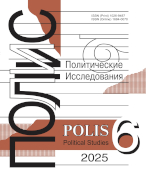Correlation between GDP per Capita and Protest Intensity:
a Quantitative Analysis
Korotayev A.V.,
Dr. Sci. (Philos.), Dr. Sci. (Hist.), Professor, Head of Centre for Stability and Risk Analysis, HSE University; Principal Researcher, Institute for African Studies, Russian Academy of Sciences, Moscow, Russia, akorotayev@gmail.com
elibrary_id: 72980 | ORCID: 0000-0003-3014-2037 | RESEARCHER_ID: N-1160-2018
Bilyuga S.E.,
post-graduate student, Faculty of Global Studies, Lomonosov Moscow State University; Junior Researcher, Center for Long-term Forecasting and Strategic Planning, Lomonosov Moscow State University, sbilyuga@gmail.com
elibrary_id: 829670 |
Shishkina A.R.,
Master of Political Science, Junior Researcher, Socio-Political Destabilization Risk Monitoring Laboratory, National Research University Higher School of Economics; Junior Researcher, Center for Civilizational and Regional Studies, Institute for African Studies, Russian Academy of Sciences, alias.shishkina@gmail.com
elibrary_id: 781188 |
DOI: 10.17976/jpps/2017.02.11
Korotayev A.V., Bilyuga S.E., Shishkina A.R. Correlation between GDP per Capita and Protest Intensity: a Quantitative Analysis. – Polis. Political Studies. 2017. No. 2. https://doi.org/10.17976/jpps/2017.02.11
Our study suggests that the relationship between per capita GDP and socio-political destabilization is not negative as tends to be believed; we are rather dealing with an inversed U-shaped relationship: the highest risks of destabilization are typical for countries with neither the lowest nor the highest values of GDP per capita, but rather with intermediate values of this indicator. Thus, up to a certain value of per capita GDP the economic growth tends to lead to an increased risk of sociopolitical destabilization, and only with relatively high values of per capita GDP its further growth tends to lead to a decrease in sociopolitical destabilization risks. Hence, for higher values of per capita GDP we observe a negative correlation between GDP per capita and the risk of social and political instability, and for lower values it is positive. An especially pronounced positive correlation of this sort is found with respect to such an indicator of sociopolitical destabilization, as the intensity of anti-government demonstrations. A very strong (r = 0,935, R2 = 0,875) statistically significant positive correlation between GDP per capita and the intensity of anti-government demonstrations can be seen in a very wide range (up to 20 000 international 2014 dollars at purchasing power parity [PPP]).Apparently, the positive correlation between, on the one hand, per capita GDP, and, on the other hand, the socio-political destabilization in general, and the intensity of anti-government demonstrations in particular, that we observe in the range of up to 20 000 dollars is one of the factors responsible for the existence of so called middle-income trap. The middle-income trap is usually defined as “the phenomenon of hitherto rapidly growing economies stagnating at middle-income levels and failing to graduate into the ranks of high-income” (according to S.Aiyar et al.). Indeed, as we see, just when an economy approaches the escape from this trap, the destabilization intensity tends to reach very high values, which could trigger particularly strong upheavals that could throw this or that country back for many years.
References
Aiyar S., Duval R., Puy D., Wu Y., Zhang L. Growth Slowdowns and the Middle-Income Trap. IMF Working Paper No. WP/13/71. International Monetary Fund, Washington, DC. 2013. 63 p. URL: http://www.longmeizhang.com/wp1371.pdf (accessed 24.01.2017).
Boix C. Democracy, Development, and the International System. – American Political Science Review. 2011. Vol. 105. No. 4. P. 809-828. DOI: https://doi.org/10.1017/S0003055411000402
Brunk G.G., Caldeira G.A., LewisBeck M.S. Capitalism, Socialism, and Democracy: An Empirical Inquiry. – European Journal of Political Research. 1987. Vol. 15. No. 4. P. 459-470. DOI: https://doi.org/10.1111/j.1475-6765.1987.tb00887.x
Burkhart R.E., Lewis-Beck M.S. Comparative Democracy: The Economic Development Thesis. – American Political Science Review. 1994. Vol. 88. No. 4. P. 903-910.
Cai F. Is There A “Middle-Income Trap”? Theories, Experiences and Relevance to China. – China & World Economy. 2002. Vol. 20. No. 1. P. 49-61. DOI: https://doi.org/10.1111/j.1749-124X.2012.01272.x
China 2030. Building a Modern, Harmonious, and Creative High-Income Society. Washington: International Bank for Reconstruction and Development. 2012. 473 p. URL: http://documents.worldbank.org/curated/ en/781101468239669951/China-2030-building-a-modern-harmonious-and-creative-society (accessed 24.01.2017).
Cutright P. National Political Development: Social and Economic Correlates. – Politics and Social Life: An Introduction to Political Behavior. Ed. by N.W. Polsby, R.A. Dentler, P.A. Smith. Boston: Houghton Mifflin. 1963. P. 569-582.
Dahl R.A. Polyarchy: Participation and Opposition. New Haven: Yale University Press. 1971. 267 p.
Epstein D.L., Bates R., Goldstone J., Kristensen I., O’Halloran S. Democratic transitions. – American Journal of Political Science. 2006. Vol. 50. No. 3. P. 551-569. DOI: https://doi.org/10.1111/j.1540-5907.2006.00201.x
Gates S., Hegre H., Jones M.P., Strand H. Institutional consistency and Political Instability: Persistence and Change in Political Systems Revisited, 1800-1998. Presented at the annual meeting of American Political Science Association, Washington D.C. 2000.
Goldstone J.A., Bates R.H., Epstein D.L., Gurr T.R., Marshall M.G., Lustik M.B., Woodward M., Ulfelder J. A Global Model for Forecasting Political Instability. – American Journal of Political Science. 2010. Vol. 54. No. 1. P. 190-208. DOI: https://doi.org/10.1111/j.1540-5907.2009.00426.x
Goldstone J.A., Gurr T.R., Harff B., Levy M.A., Marshall M.G., Bates R.H., Epstein D.L., Kahl C.H., Surko P.T., Ulfelder J.C., Unger Jr., Unger A.N. State Failure Task Force Report: Phase III Findings. McLean, VA: Science Applications International Corporation (SAIC). 2000. 255 p. URL: https://www.hks.harvard.edu/fs/pnorris/Acrobat/stm103%20articles/StateFailureReport.pdf (accessed 16.05.2016).
Grinin L.E., Isaev L.M., Korotayev A.V. Revolyutsii I nestabil’nost’ na Blizhnem Vostoke [Revolutions and Instability in the Middle East]. Moscow: Mosk. red. izd-va “Uchitel’”. 2015. 384 p. (In Russ.)
Groves A. Discuss and Evaluate the Relationship between Poverty and Terrorism. – E-International Relations. 2008. 04.01. URL: http://www.e-ir.info/2008/01/04/discuss-and-evaluate-the-relationship-between-poverty-and-terrorism/ (accessed 16.05.2016).
Gurr T.R. Persistence and Change in Political Systems, 1800-1971. – American Political Science. 1974. Vol. 68 (December). P. 1482-1504. DOI: https://doi.org/10.2307/1959937
Huntington S. Political Order in Changing Societies. New Haven, CT: Yale University Press. 1968. 488 p.
Jenkins J.C., Wallace M. The Generalized Action Potential of Protest Movements: The New Class, Social Trends, and Political Exclusion Explanations. – Sociological Forum. 1996. Vol. 11. No. 2. P. 183-207. DOI: https://doi.org/10.1007/BF02408364
Kharas H., Kohli H. What Is the Middle Income Trap, Why Do Countries Fall Into It, and How Can It Be Avoided. – Global Journal of Emerging Market Economies. 2011. Vol. 3. No. 3. P. 281-289. DOI: https://doi.org/10.1177/097491011100300302
Kiendrebeogo Y., Ianchovichina E. Who Supports Violent Extremism in Developing Countries? Analysis of Attitudes Based on Value Surveys. Policy Research Working Paper. 2016. 61 p. URL: http://www-wds.worldbank.org/external/default/WDSContentServer/WDSP/IB/2016/06/02/090224b08438a637/2_0/Rendered/PDF/ Who0supports0v0sed0on0value0surveys.pdf (accessed 20.05.2016).
Knutsen C.H. Income Growth and Revolutions. – Social Science Quarterly. 2014. Vol. 95. No. 4. P. 920-937. DOI: https://doi.org/10.1111/ssqu.12081
Kohli H.A., Mukherjee N. Potential Costs to Asia of the Middle Income Trap. – Global Journal of Emerging Market Economies. 2011. Vol. 3. No. 3. P. 291-311. DOI: https://doi.org/10.1177/097491011100300303
Korotayev A.V., Isaev L.M., Vasil’ev A.M. Quantitative Analysis of the 2013–2014 Revolutionary Wave. – Sociological Studies. 2015. Vol. 8. No. 376. P. 119-127. (In Russ.)
Korotayev A.V., Slin’ko E.V., Shul’gin S.G., Bilyuga S.E. Intermediate Types of Political Regimes and Socio-Political Instability: Quantitative Cross-National Analysis. – Politeia. 2016. Vol. 3. P. 31-52. (In Russ.)
Korotayev A., Issaev L., Zinkina J. Center-Periphery Dissonance as a Possible Factor of the Revolutionary Wave of 2013-2014: A Cross-National Analysis. – Cross-Cultural Research. 2015. Vol. 49. No. 5. P. 461-488. DOI: https://doi.org/10.1177/1069397115595374
Korotayev A.V., Issaev L.M., Malkov S.Y., Shishkina A.R. The Arab Spring: A Quantitative Analysis. – Arab Studies Quarterly. 2014. Vol. 36. No. 2: P. 149-169. DOI: https://doi.org/10.13169/arabstudquar.36.2.0149
Lipset S.M. Some Social Requisites of Democracy: Economic development and political legitimacy. – American Political Science Review. 1959. Vol. 53. No.1. P. 69-105. DOI: https://doi.org/10.2307/1951731
Londregan J.B., Poole K.T. Does High Income Promote Democracy? – World Politics. 1996. Vol. 49. P. 1-30. DOI: https://doi.org/10.1353/wp.1996.0024
MacCulloch R. The Impact of Income on the Taste for Revolt. – American Journal of Political Science. 2004. Vol. 48. No. 4. P. 830-848. DOI: https://doi.org/10.1111/j.0092-5853.2004.00104.x
MacCuloch R., Pezzini S. The Role of Freedom, Growth and Religion in the Taste for Revolution. – The Journal of Law & Economics. 2010. Vol. 53. No. 2. P. 329-358. DOI: https://doi.org/10.1086/605093
Mansfield E., Snyder J. Democratization and the Danger of War. – International Security. 1995. Vol. 20. No. 1. P. 5-38. DOI: https://doi.org/10.2307/2539213
Marshall M.G., Cole B.R. A Macro-Comparative Analysis of the Problem of Factionalism in Emerging Democracies. Paper Presented at the 2008 Annual Meeting of the American Political Science Association.2008.
Miguel E., Satyanath S., Sergenti E. Economic Shocks and Civil Conflict: An Instrumental Variables Approach. – Journal of Political Economy. 2004. Vol. 112. No. 4. P. 725-753. DOI: https://doi.org/10.1086/421174
Moore B. Social Origins of Dictatorship and Democracy. Boston: Beacon Press. 1966. 592 p.
Parvin M. Economic Determinants of Political Unrest: An Econometric Approach. – Journal of Conflict Resolution. 1973. Vol. 17. No. 2. P. 271-291.
Rueschemeyer D., Stephens E.H., Stephens J.D. Capitalist Development and Democracy. Chicago: University of Chicago Press. 1992. 398 p.
Ulfelder J., Lustik M. Modeling Transitions to and from Democracy. – Democratization. 2007. Vol. 14 (April). P. 351-387. DOI: https://doi.org/10.1080/13510340701303196
Vreeland J.R. The Effect of Political Regime on Civil War. – Journal of Conflict Resolution. 2008. Vol. 52. No. 3. P. 401-425. DOI: https://doi.org/10.1177/0022002708315594
Weede E. Income Inequality, Average Income, and Domestic Violence. – The Journal of Conflict Resolution. 1981. Vol. 25. No. 4. P. 639-654.
See also:
Parma R.V., Rastorguev S.V., Tyan Yu.S.,
Influence of political institutions on economic growth in the countries of the world. – Polis. Political Studies. 2022. No1
Pantin I.K.,
To the question of the character of the October revolution. – Polis. Political Studies. 2013. No6
Pantin I.K.,
Russian revolution as a problem of political philosophy. – Polis. Political Studies. 2011. No5
Pastukhov V.B.,
One Back Step, Two Steps Forward (Russian Society and State within an Intercultural Span). – Polis. Political Studies. 2005. No6
Rozov N.S.,
Crisis and Revolutions: Fields of Interaction, Actors’ Strategies, and Trajectories of Conflict Dynamics. – Polis. Political Studies. 2017. No6




.jpg)






 print
print
.jpg)
.jpg)